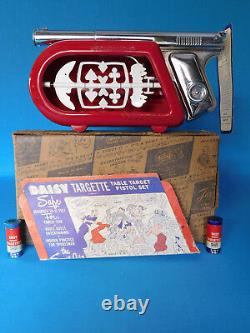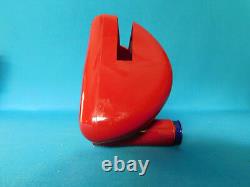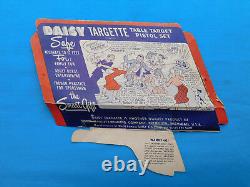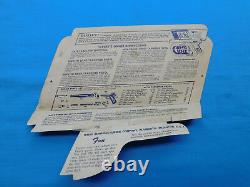Vintage Daisy Targette. 118 Pistol Complete As Sold New Extremely Rare Box














118 BB PISTOL For your consideration is a very rare Daisy Targette nickel plated. It includes the VERY RARE TARGETTE SHOOTING GALLERY!
These were only available from 1949 to 1952. It will include the gun, gallery target, 2 metal tins of.
118 BB's, all paper work and the box! Note: When gun is cocked back the trigger sticks sometimes. May need to be lubed or adjusted. If you have any questions, feel free to ask and I will get back to you ASAP. I package everything extremely well to assure you of receiving your item in same condition as pictured.
Thanks for looking and please visit my store for many other items. Special shot for a special gun The Targeteer's action is a spring-piston design that has to be the world's weakest BB gun!
Instead of shooting conventional steel BBs, it shot special. 118-caliber steel shot that Daisy made just for this gun. If you read about the Sharpshooter rubber-band catapult gun in my May 11 posting, you'll remember that they are the same caliber as the Targeteer. The Sharpshooter shot traditional No. 6 lead birdshot that's used in shotgun shells.The Targeteer's ammo was steel! Only a company as large as Daisy had the resources to make a steel version of this shot!
Regular BBs dwarf the tiny Targeteer shot. The Targeteer operates just like a conventional Daisy rifle in all ways but cocking. To cock it, pull the barrel back into the action. Most people simply pushed the muzzle back with the heel of their hand while holding the grip in their other hand, which means they're cocking a gun with they're hand over the muzzle!
Not a bang but a whimper The Targeteer discharges with an anemic sound, much like a mouse coughing. When the piston jumps forward, the BB exits the muzzle at, perhaps, 100-150 f. Being very light as well as slow, the BB cannot break windows, lightbulbs or even one sheet of paper at a distance greater than 10 feet. That's why the cardboard box was good enough as a backstop. Even though this gun lacks power, it's fun to shoot!
The Targeteer lasted up to World War II, then resumed production after the war. Nickel-plated versions (often mistakenly called chrome-plated) were available after the war, as was a very pretty plastic shooting gallery model that housed the gun on top of the gallery when not in use. The gallery was only offered from 1949 through 1952 and is considered a prized Daisy collectible in its own right. A fancy shooting gallery also held a nickel-plated Targeteer when not in use.

